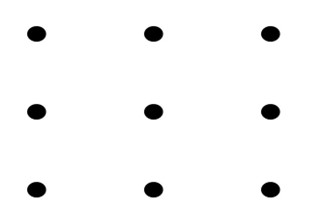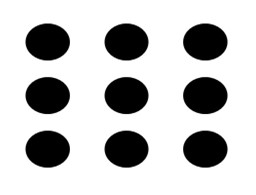
GUEST POST from Dennis Stauffer
One of the ways innovators—and everyone else—so often get tripped up is by our own hidden assumptions. Beliefs we aren’t consciously aware of. These assumptions can make our challenges much harder than they need to be.
I’m sure you’ve heard the expression “Thinking outside the box.” That most overused creativity cliché. You probably don’t know where that metaphor came from, but I suspect you’ve seen it, and it illustrates this difficulty.
It’s called the nine-dot problem. Remember this? You’re supposed to connect all nine dots with four straight lines that are all connected and continuous. One long line with four segments. See if you can figure out (or recall) the solution.

What makes the nine-dot problem hard to solve—when you haven’t seen it before—is an assumption you probably made without realizing it. You assumed that those lines must fall within the space defined by those dots, that they’re inside the box. Once you realize you can go outside the box, it becomes much easier. You can see the solution HERE.
This puzzle goes back at least to the 1970s. Since then, many variations have been suggested. Here’s one that prompts a different hidden assumption.

Think of it as perhaps a new assignment for your team:
Folks, we hit it out of the park on that nine-dot program. That solution gave us a very profitable competitive advantage. But it’s been a while. Our competitors are catching up. We need an update. Our new challenge is similar. There are still nine dots, but they’re a little bigger, a little closer together, and our budget is smaller. We can only afford three lines instead of four. Otherwise, our challenge is the same—connect all the dots. So how do we do that with just three straight lines that are connected and continuous?
Can you figure this one out? If you don’t immediately see the solution, it’s probably because you’re making another assumption that you don’t realize you’re making. You’re assuming that you must go through the centers of the dots. But that’s not required. The lines can tilt. Without that limitation—that hidden assumption—the solution is much more straightforward. That solution is HERE.
I’m not telling you to stop making assumptions. That’s a fool’s errand. We all make assumptions, every moment of our lives, or we couldn’t function. You can’t check out everything. What I recommend instead is that you recognize that you’re always making assumptions and get better at identifying them. That way you can decide whether they’re appropriate. In other words, you need to be willing to challenge your own thinking—your own mindset.
Innovators are willing to question even what may seem obvious, because that’s how you gain new insights and make discoveries. And because learning how to understand this world in some new way is the first step toward making it better.
View this post as a video on YouTube here:
Image Credit: Unsplash
![]() Sign up here to get Human-Centered Change & Innovation Weekly delivered to your inbox every week.
Sign up here to get Human-Centered Change & Innovation Weekly delivered to your inbox every week.